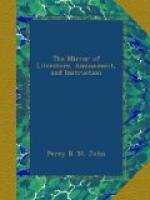“The London Zoological Society has certainly the merit of taking the lead in this description of garden; but Mr. Cross has not only proceeded more rapidly than they have done, but has erected more suitable and more imposing structures than are yet to be found in the gardens in the Regent’s Park. What is there, for example, in the latter garden which can be at all compared with the circular glass building of 300 ft. in diameter, combining a series of examples of tropical quadrupeds and birds, and of exotic plants? In the plan of this building, the animals (lions, tigers, leopards, &c.) are kept in separate cages or compartments towards the centre; exterior to them is a colonnade, supporting the glazed roof, and also for cages of birds; within this colonnade will be placed hot-water pipes for heating the whole, and beyond it is an open paved area for spectators; next, there is a channel for a stream of water, intended for gold, silver and other exotic fishes; and, beyond, a border, under the front wall, for climbing plants, to be trained on wires under the roof. It is singular that the elevation of this building is almost a fac simile of the elevation which we made in May last for the hot-houses of the Birmingham Horticultural Society’s garden; the only difference being, as it will afterwards appear, the addition, in our plan, of exterior pits, and of pediments over the entrance porches. The curvilinear sash-bars in Mr. Cross’ building are of iron, by Brown of Clerkenwell, and the glazing is beautifully executed by Drake of the Edgeware Road."[1]
Notwithstanding the wintry aspect of the day, we found a group of visiters in this new curvilinear-building, who were inspecting their mightinesses the lions and large quadrupeds. There were likewise family parties in the walks, and each of the rustic buildings had its visiters. One of the prettiest additions is a beaver-dam, with picturesque and tower-like crag for the larger specimens of the Falco tribe. The enclosures for Indian and other rare cattle also aid the interesting character of the whole scene. A long glazed building is likewise in progress for monkeys, who may thus disport their recreant limbs in an exotic atmosphere. Apart from these attractions, the grounds themselves have some of the most beautiful features of landscape gardening: they abound with what artists consider bits of the picturesque. The quadrupeds and birds must surely rejoice at their removal from the murky dens of Exeter ’Change to so delightful a region as the present, even slightly as it assimilates with the luxuriance and vastness of their native forests and plains.
Above all, we are happy to find that two eminent naturalists, Messrs. Swainson and Gray have become “honorary zoologists” to this Establishment: all the animals will be first submitted to their inspection, and the species accurately defined by them; so that the advancement of zoological science will be associated with popular gratification.




